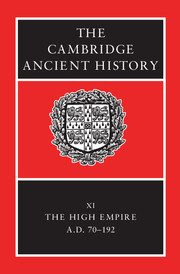Book contents
- Frontmatter
- PART I NARRATIVE
- PART II GOVERNMENT AND CIVIL ADMINISTRATION
- PART III THE EMPIRE
- 8 Frontiers
- 9 The army
- 10 Local and provincial institutions and government
- 11 Rebels and outsiders
- PART IV ROME, ITALY AND THE PROVINCES
- PART Va ECONOMY AND SOCIETY
- PART Vb ART AND CULTURE
- Chronological Table
- BIBLIOGRAPHY
- Index
- 1 The Roman world in the time of Marcus Aurelius
- 7 The Danube provinces
- References
10 - Local and provincial institutions and government
from PART III - THE EMPIRE
Published online by Cambridge University Press: 28 March 2008
- Frontmatter
- PART I NARRATIVE
- PART II GOVERNMENT AND CIVIL ADMINISTRATION
- PART III THE EMPIRE
- 8 Frontiers
- 9 The army
- 10 Local and provincial institutions and government
- 11 Rebels and outsiders
- PART IV ROME, ITALY AND THE PROVINCES
- PART Va ECONOMY AND SOCIETY
- PART Vb ART AND CULTURE
- Chronological Table
- BIBLIOGRAPHY
- Index
- 1 The Roman world in the time of Marcus Aurelius
- 7 The Danube provinces
- References
Summary
This chapter complements Chapter 7, which deals with provincial administration and finance; it analyses the same phenomenon, but from the point of view of those governed rather than those who governed them. The period to be dealt with here extends from one military crisis to another. On the whole it was a period of peace, both within the empire and – after Trajan's reign – in the frontier areas. Some dramatic moments in the reign of Marcus had announced the perils of war on two frontiers, insurrection within the empire and the plague, but fortunately the inhabitants of the Roman empire did not know what was to follow. This was the golden age in the opinion of Gibbon and of Mommsen, but it is a golden age for historians also, in the sense that it abounds in primary sources of all kinds, literary, epigraphical, papyrological and archaeological. That there are still so many problems inherent in the subject of this chapter is mostly to be attributed to the Romans themselves, who wrote little on the administration of empire (compared with the literature on the administration of justice), and suppressed most of this when putting together the Digest in the time of Justinian. Modern historians are no more explicit: literature abounds on points of detail, and there are magisterial works like Millar's on the role of the Roman emperor in his world, but the last exhaustive treatment of the administration of Rome and its empire dates from the end of the last century. Even concise introductions to the working of the Roman empire are rare.
- Type
- Chapter
- Information
- The Cambridge Ancient History , pp. 344 - 360Publisher: Cambridge University PressPrint publication year: 2000
References
- 27
- Cited by

